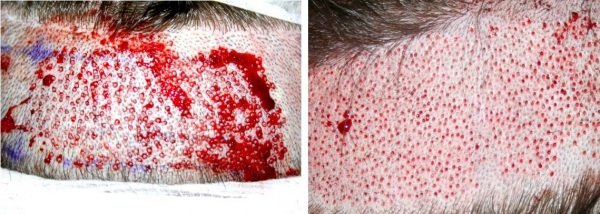There are three main ways to perform a hair transplant in the modern era. The first, and best, is via strip (also known as Follicular Unit Transplant (FUT)). The second is FUE. And the third are the middle ground between the two called Non Strip Harvest (or mFUE, or NST depending on the clinic. The names are a bit different but the procedure is largely the same). Here we show photos taken in the middle of an FUE case and at the end.

Dr. Feller performs FUE in Great Neck, NY.
In the left photo you see grafts that have been “scored” in preparation for removal. On the right you see what the area looks like about an hour after the grafts have been removed.
The benefit of this procedure is that there is no linear scar, the disadvantage is that it causes more damage to the donor area and the grafts don’t grow as well on average. For patients who don’t have the option of FUT, usually due to very low density, FUE becomes a very attractive alternative.
While FUE has it’s place, it’s definitely not “first place”. While proponents of FUE claim it is a major leap forward in technology it simply isn’t. In reality it is the oldest hair transplant procedure known having been performed and documented in 1930’s Japan. Since then a far better, efficient, and safer method of surgical hair restoration has been invented, that being Follicular Unit Transplant (FUT).
While those little holes you see in the right hand photo may look benign, in reality there is a tremendous amount of unnecessary damage under the skin with more to come. As the skin heals scar tissue will be produced which will change the vascularity, neurology, texture, and turger of the skin. This is a necessary result of FUE and there are no exceptions. Rather than a small area of trauma confined to a single line, this patient will now have damage throughout his donor area which will limit the amount of grafts he could get in a second procedure should he decide to have one.
By the way, don’t be too concerned with what appears to be a lot of blood in the left photo. Most of that is just water that had been pumped into the skin to protect it. As it leaks out and comes in contact with a few drops of blood the entire volume turns red making it look scarier than it really is.
What is Surgical Hair Restoration ?

